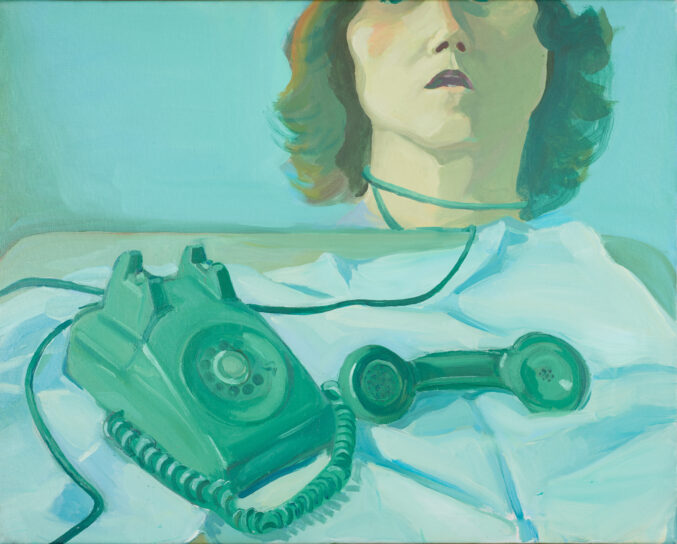Maria Lassnig, Self-Portrait with a Telephone, 1973
Collection Lentos Kunstmuseum Linz
© Bildrecht Wien, 2021

Oil on canvas, 72,5 x 90 cm
Collection Lentos Art Museum Linz, Inv. Nr. 434
Having trained as a primary schoolteacher, Maria Lassnig (born in 1919 in Kappel am Krappfeld, Carinthia; died in Vienna in 2014) enrolled at the Akademie der bildenden Künste in Vienna, where she studied under Wilhelm Dachauer between 1941 and 1943, then under Ferdinand Andri and Herbert Boeckl, and finally under Albert Paris Gütersloh. Works dating from this early period are marked by an expressive realism, for which the influence of Herbert Boeckl was decisive. By 1948 Lassnig concerned herself primarily with surrealism and late cubism. In 1948 she had her first exhibition in Klagenfurt. In 1951 Maria Lassnig was awarded a bursary for a stay in Paris, where she and Arnulf Rainer met André Breton and Paul Celan. In the early 1950s drawings and paintings were taking shape that had their point of departure in surreal automatism and incorporated impulses from Informel. By 1956 Maria Lassnig was in close contact and exchanged ideas with artists associated with the Galerie nächst St. Stephan (Mikl, Hollegha, Prachensky and Rainer), where an exhibition of her works was organised in 1960. Between 1961 and 1968 Maria Lassnig again lived in Paris, where she created the first “Körpergefühlsfigurationen [Body Sensation Figurations]” and “Körperbewusstseinsmalereien [Body Awareness Paintings]”. Here bodies dissolve into amorphous figures. Between 1968 and 1980 Lassnig lived in New York, where she attended a three-month course at the School of Visual Arts studying animated film. By 1971 she was making her first animated films, which eventually came to represent a significant part of her oeuvre. In the 1970s her painting took a turn towards realism. It includes a great number of self-portraits and themes that address female consciousness, interpersonal relations, and animal symbolism. In 1971 her works were shown in the exhibition “Die Anfänge des Informel in Österreich [The Beginnings of Informel in Austria]” at the Museum des 20. Jahrhunderts in Vienna alongside Arnulf Rainer and Oswald Oberhuber. In 1972 she took part as an avant-garde animated film maker in the “International Woman Film Festival” in New York and in 1979 in the Forum des Jungen Filmes, which was part of the Berlinale. In 1980 she returned to Vienna to accept a chair at the University of Applied Arts, becoming the first female professor of painting in a German-speaking country. She established a studio for animated film in 1981 and continued to teach until 1997. In 1980 she represented Austria with Valie Export at the Venice Biennale, and in 1982 at the documenta 7 in Kassel. The 1980s saw a surge in Lassnig exhibitions both in Austria and abroad, such as at the Kunstverein Hannover (1982), the Museum moderner Kunst in Vienna (1985), the Albertina (1989), the Rupertinum in Salzburg, the Wiener Secession (1990), and the Neue Galerie am Landesmuseum Johanneum Graz. In 1993 she was represented in “Der zerbrochene Spiegel” [The Broken Mirror] in the Kunsthalle Wien, in 1994 at the Stedelijk Museum in Amsterdam, in 1995 again at the Venice Biennale (“Identità e Alterità”), at the Centre Pompidou in Paris (“Feminin-Masculin”, 1996) and at the Istanbul Biennale. A selection of her works was on display at the documenta 10 in 1997. In 1999 the Museum moderner Kunst in Vienna put on a great solo exhibition. In March 2002 she was awarded the Werner Haftmann Prize.